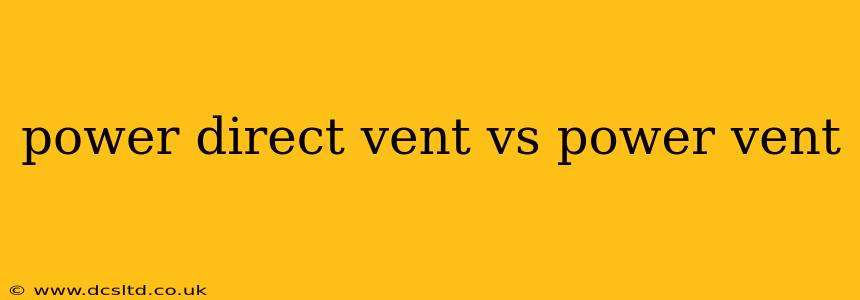Choosing the right venting system for your gas appliance is crucial for safety and efficiency. Two common types are power direct vent and power vent systems. While both use a blower to exhaust combustion byproducts, key differences exist that impact performance, installation, and cost. This guide will clarify the distinctions between power direct vent and power vent systems, helping you make an informed decision.
What is a Power Vent System?
A power vent system uses a blower motor to exhaust combustion gases through a single vent pipe. The exhaust is expelled to the outside, while the appliance draws in its combustion air from the same room where it's located. This means the appliance relies on the room's existing air supply for proper combustion. This system is simpler and often less expensive to install than a direct vent system.
What is a Power Direct Vent System?
A power direct vent system also utilizes a blower motor, but it incorporates a double-walled vent pipe. This cleverly designed system draws in combustion air from the outside and expels exhaust gases outside through separate, concentric pipes. This means it doesn't rely on the indoor air for combustion, minimizing the risk of carbon monoxide buildup or backdrafting.
Power Direct Vent vs. Power Vent: Key Differences Summarized
| Feature | Power Direct Vent | Power Vent |
|---|---|---|
| Air Intake | Draws combustion air from outside | Draws combustion air from the same room |
| Exhaust | Exhausts combustion gases outside through a separate pipe | Exhausts combustion gases outside through a single pipe |
| Vent Pipe | Double-walled concentric pipe | Single-walled pipe |
| Installation | More complex, potentially requiring exterior access | Simpler installation |
| Cost | Generally more expensive | Generally less expensive |
| Safety | Safer, reduces risk of carbon monoxide poisoning | Higher risk of backdrafting and CO buildup |
| Efficiency | Can be slightly more efficient | Can be slightly less efficient |
What are the pros and cons of each system?
Power Direct Vent Pros:
- Enhanced Safety: Reduced risk of carbon monoxide poisoning due to the separate air intake.
- Improved Efficiency: In some cases, it can be slightly more energy-efficient by drawing in cooler outside air.
- Better Air Quality: Prevents the introduction of indoor air into the combustion process.
Power Direct Vent Cons:
- Higher Installation Cost: More complex installation due to the double-walled vent system and potentially necessary exterior access.
- More Complex Design: Requires a more intricate venting system.
Power Vent Pros:
- Lower Installation Cost: Simpler installation, often less expensive.
- Simpler Design: Easier to install and maintain.
Power Vent Cons:
- Safety Concerns: Higher risk of carbon monoxide poisoning due to reliance on indoor air.
- Potential for Backdrafting: Improper venting can lead to backdrafting, pushing exhaust gases back into the room.
- Reduced Efficiency: Slightly less efficient due to the utilization of room air, which can already be heated.
How do I choose between a power direct vent and a power vent system?
The best choice depends on your specific needs and priorities. If safety is your paramount concern, a power direct vent system is recommended. However, if budget is a significant factor and the installation allows for it, a power vent system might be sufficient. Always consult with a qualified HVAC professional to determine the most appropriate venting system for your home and appliance based on local codes and your specific circumstances.
Which system is better for my home?
There's no single "better" system. The optimal choice depends on factors like:
- Local Building Codes: Compliance with local building codes is mandatory.
- Home Construction: The ease of running a vent pipe externally can influence the choice.
- Budget: Power direct vent systems generally cost more to install.
- Safety Concerns: Power direct vent systems offer superior safety.
A qualified HVAC technician can assess your home and recommend the best option.
Can I convert a power vent system to a power direct vent system?
Generally, converting an existing power vent system to a power direct vent system isn't feasible. It would require significant modifications to the venting system and likely necessitates a complete system replacement, rather than a simple conversion.
Remember to always consult with a qualified HVAC professional for any venting system installations or modifications. Proper installation is crucial for safety and efficiency.
